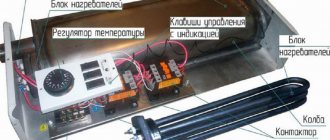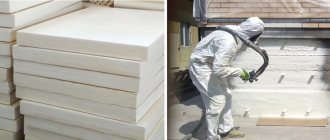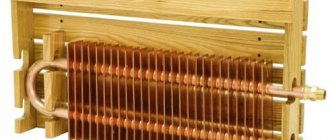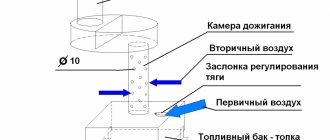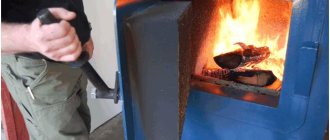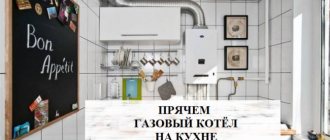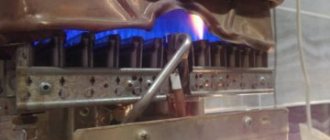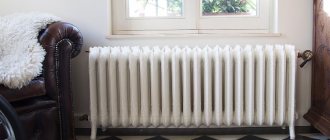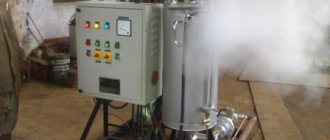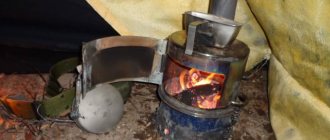In an effort to save on heating, many home “do-it-yourselfers” make various devices. A DIY boiler, which can often be seen in a private home, is one such useful device.
There are various varieties of it. If you have the skills to work with a welding machine and metal, you can save significantly on heating installations.
Varieties
Before directly manufacturing a boiler for heating a house, you need to decide on its configuration and type. Depending on the type of coolant heating, boilers are:
- Gas;
- Wood-burning;
- Coal;
- Electrical;
- Pyrolysis;
- Oily;
- Pellet
As for the configuration, it can be anything:
- Round;
- Rectangular;
- Trapezoidal;
- Conical
The nuances of placing the finished structure
There are three main ways to place the structure: inside, outside or in the garage. Each of the options has its own characteristic features.
Accommodation inside the house
If a homemade gas boiler for heating and heating needs to be located inside the house, you will have to allocate a separate room for it. The room should be dry, with a stable temperature and low humidity. Access to the boiler must be free. A natural or forced air circulation system is installed. To operate the automation, electric current is carried out. Most modern outlets have built-in grounding, so there is no need to create a separate one.
Placing the boiler outside the house
If there is not enough space inside the house to accommodate the boiler, it is placed in an extension. Basic requirements for the premises:
- The area of the room is at least 5 square meters. m.
- Stable temperature above +7 ᵒС. To do this, you will have to insulate the extension.
- The building requires electricity and an outlet to be installed.
All pipes supplying and discharging coolant must be insulated. Otherwise, in winter, a significant amount of energy will be lost during transportation from the extension to the house.
Placing the boiler in the garage
If it is not possible to locate a boiler room inside the garage, it is advisable to build an extension. The garage contains a large amount of carbon dioxide released when the car is running, the boiler increases its concentration, which creates a health hazard.
If there is a gas leak inside the garage, a fire may occur due to gasoline vapors, containers with oil and other fuels and lubricants. Therefore, placing homemade equipment in this room is undesirable.
How to make a boiler correctly
During the design process, it is necessary to take into account some design features and the principle of its operation. In particular, you need to decide on the purpose of the boiler and what type it will be. The easiest way is to make a solid fuel boiler with your own hands.
Much more difficult, almost impossible, is gas, since it is subject to increased safety requirements. You need to get permission to use it and check it. And - if all the characteristics of the device do not meet the required ones, then the relevant authorities will simply prohibit such a boiler from use.
The efficiency of the boiler is influenced by both the design (coolant capacity), the rate of fuel combustion, and the constant flow of fresh air (oxygen). It should be taken into account that the fuel burns completely and there is a possible outflow of gas, which carries a lot of heat, which must be prevented.
Advantages and disadvantages
Due to its large dimensions and complexity of the design, it is rational to use such a unit for heating a large cottage. But for a small dacha this option is not suitable, as it does not justify the cost-effectiveness.
pros
- high efficiency (about 95%);
- autonomy of the heating system;
- efficiency;
- reliability and durability;
- high efficiency;
- fuel availability;
- an environmentally friendly option for heating your home;
- versatility of fuel (coals, firewood, sawdust, pellets).
Read our material about which long-burning boilers are better.
Minuses
- cumbersome design;
- a special room must be equipped for the device;
- complexity of design and installation;
- the need for constant cleaning.
It is not necessary to buy a long-burning boiler ready-made, because its price is several times higher than conventional stoves. You can make such a design yourself if you have at least a little experience in construction and repair.
Appearance of a homemade structure
A homemade design, compared to a factory-made analogue, has a number of advantages:
- low cost;
- the ability to make the boiler universal for any type of fuel;
- possibility of improving the design and adding power.
The only difficulty is giving the boiler a cylindrical shape. It is very difficult to give metal such a shape without a rolling machine.
But there is a good solution. You can use empty propane tanks or any pipe of suitable diameter. You should choose pipes with a wall thickness of at least 5 mm.
For a village or a small dacha, you can build a small brick stove and enjoy its efficiency. But for a large cottage, this option will be less practical, as it will require a large supply of firewood for the winter. Caring for a conventional stove, compared to a long-burning boiler, is much more difficult, and large temperature changes in rooms remote from the stove do not allow organizing a comfortable microclimate in the house.
If you do not have enough money to create a full-fledged heating system for your home, or the construction of such a system itself is impractical, it would be much more reasonable in this situation to make a long-burning solid fuel boiler with your own hands and not worry about its safety and aesthetic appearance.
Some features
The boiler configuration, its characteristics, drawings will depend on many factors:
- Material. Regular steel (sheet) will do, but heat-resistant stainless steel or cast iron is best.
- Possibility of good processing of steel, reliable connection of structural parts. Usually, a grinder, a gas cutter and electric welding are used for this.
- Type and characteristics of fuel (liquid or solid). Steel must withstand high temperatures, not deform, and not melt under their influence. Withstand internal pressure of vapors and gases without ruptures or cracks.
- Correct calculation of the coolant circulation method. Will it be natural (due to correct manipulation of pipe diameters, their slope, tank height, etc.) or forced (using a pump in the circuit).
- Taking into account vapor pressure, using valves to discharge excess gases and condensate (installation of return lines).
It is important in the process of designing a boiler and including it in the heating circuit to carefully think through everything. What and how will work after assembly.
Making a heating boiler with your own hands is not that difficult. All problems usually begin later, when something is not taken into account or done clumsily.
Assembling the heating unit
After assembling the foundation and preparing the brick base, you can move on to the body. The body is made from a 425 mm pipe. If you need to heat a small area, a height of just over 1 m is sufficient, even taking into account the small radius.
After measuring and marking, you can cut the pipe. The edges are processed with a grinder. Holes need to be cut on the body:
- For firebox (200x100) mm.
- For the blower (200x30 mm).
The combustion hole is located above the ash pit.
The distance from the edge to the blower is made at least 7 cm, as is the distance between the holes.
Holes are made for supply and return of coolant. Their diameter is 25 mm. They are located opposite each other on different sides of the pipe. Afterwards, the leads are welded to them.
Three disks with a diameter of 425 and 412 mm are made from steel sheets. The latter is attached inside the housing. In two of them, the larger and smaller, holes with a radius of more than 50 mm are cut. The chimney for the installation is made from a 100 mm metal pipe. For the legs, pieces of metal up to 5 cm thick are cut out. A grate for the ash pan is made from the fittings.
A chimney is attached to a pancake with a diameter of 412 mm. A temporary stop is attached inside the housing at a height of about 30 cm from the bottom of the firebox opening. It is made of wire or reinforcement. A disk with a pipe is lowered onto it.
Main joints
An important point in the assembly is the connection of the pancakes and the body to each other. The seam must be welded on both sides and done as reliably as possible: in this area the firebox and tank are connected.
After welding is completed, a plate with a diameter of 425 mm is put on the chimney. It is necessary to securely attach both seams by welding.
Combustion compartment
A metal gas chamber is installed on the back side of the chimney. It is attached inside the housing, a heat exchanger is made from a steel tank and a copper tube, which must be bent in the form of a serpentine. It is then inserted into the tank and secured with fittings. During operation, the copper spiral will heat up from the burner and transfer heat to the tank.
The heat exchanger is attached to the corners directly above the burner. Electronic components are fixed inside according to the drawing.
Burner
Lower body
At the end of the work, a large pancake is fixed, which serves as the bottom of the hull. Then legs 5 cm high are welded to it. Then the hinges are secured.
Blower valve design
This design can vary in design. Usually made in the form of a door or damper.
Manufacturing instructions
When you have everything you need (material and tools), all that remains is to assemble the boiler in the following sequence:
- We take 2 barrels with different diameters, wall thickness of at least 4 mm;
- Use a grinder to cut out holes for the ash pan and water container;
- We install one cylinder of smaller diameter inside the other;
- We weld the lid over them, the ash pan, and the firebox;
- Close the door;
- We weld water pipes, a pipe for a check valve (pressure relief);
- We install a grate inside the oven;
- We make a hole for the chimney;
- Install the pipe;
- We check the tightness.
When there are no leaks in the boiler, it is connected to the heating system and water supply network.
If used oil or antifreeze is used as a coolant, they will be filled in manually. Connections to the water supply system and welding of pipes are not required for this.
After installing the boiler into the heating system with your own hands, you need to check that it is working correctly. A properly assembled device will heat the coolant (water or oil) during the combustion process. If he does this poorly, then you should check for air pockets in the heating network and reduce the vapor pressure by releasing them.
In any case, you need to understand the operating principle of this type of boiler so that there are no excesses or problems during its operation.
DIY fan: how to make a homemade powerful fan. Basic parameters and properties of fans (130 photos)- Why do you need a security alarm, what functions does it perform?
How to choose winter workwear and not make a mistake - recommendations from the pros
What do you need for work?
First of all, the workshop, that is, the place where you will manufacture the main components and assemble the unit. In addition, you will need a fairly extensive list of tools, which can safely include:
- welding mask, gaiters and overalls;
- household inverter welding machine and electrodes;
- circular saw with a set of discs for cutting metal;
- electric drill with a set of metal drills;
- tape measure, squares, building level.
To assemble a solid fuel boiler, you will need the following materials:
- steel sheets with a thickness of 5 mm;
- metal corners;
- cast iron grate;
- steel water pipes of various diameters;
- doors for the ash and combustion chamber;
- stove-type throttle valves.
Before you begin manufacturing the elements and components of the boiler, you need to perform structural calculations, decide on a circuit diagram and draw a drawing of the boiler, not forgetting to indicate all its structural components and their main parameters.
Smoke exhaust of a solid fuel boiler: inside and outside the building
And most importantly: observe safety precautions both during the work process and in relation to the quality of the solid fuel boiler. The slightest mistake on your part can cause serious problems, incl. increased risk of fire.
Chimney installation
For the first firebox, a temporary galvanized iron pipe 2-3 meters long is suitable. When installing the boiler at a place of permanent operation, you need to install a more reliable chimney. It is more practical to use pipes made using sandwich technology (50-70 mm of basalt wool is laid between the outer and inner pipes). Application is convenient in that the kit includes the necessary fasteners and additional elements for wiring the chimney through the ceiling, roof; two people are enough for installation.
When wiring a chimney through ceilings or a roof, you need to carefully waterproof the joints, do not forget about fire safety measures - use only non-flammable, heat-resistant materials (steel, mineral wool, silicone sealants, cement).
Assembly phase
General information
Important: The law prohibits the use and installation of gas equipment without obtaining the appropriate permission from the responsible organization, which will require a certificate of conformity for the device.
You must understand that it will be extremely difficult to obtain this type of document for a homemade device. Minor deviations from the norms will result in a complete ban on the installation of a homemade device.
Types of gas units
Boilers differ in the following parameters:
The number of circuits is single-circuit and double-circuit. Single-circuit units perform only one function, namely heating the water and pipes of the house. The second type heats the house and provides hot water;- method of removing combustion products - having natural draft and with supply draft. For the first option, air is supplied from the street, and for the second, a chimney pipe is required;
- ignition method - electric type, when work occurs, and having a piezoelectric element, in which the device is ignited with one’s own hand;
- depending on the mounting method - wall and floor;
- control method - single-stage and two-stage;
- connection method - to the central gas pipeline or to a gas cylinder;
- according to the material of manufacture - steel, cast iron and copper.
Device principle
The design of the gas unit contains the following elements: burner, heat exchange device, pumping device, expansion tank, automatic system, ventilation device, protective system, temperature measuring device, solenoid valve, air vent.
When the device is turned on, the gas burner ignites, which heats the heat exchanger with water or antifreeze. The action of the pumping device creates excess pressure, due to which there is a continuous circulation of the thermal energy transmitter in the pipes and the release of thermal energy through radiators. Then the cold coolant flows back into the boiler.
Internal details
The internal parts of the heating device are cut out according to the pattern using a grinder or drill (in places where it is impossible to cut with an angle grinder). They work according to an algorithm - drilling closely spaced holes along the contour of the part, cutting jumpers with a chisel or small sledgehammer).
When cutting parts, you must strictly observe the dimensions and not deform the sheet of metal. During final assembly there will be alignment problems and gaps that are too large.
Boiler - general view without chimney

